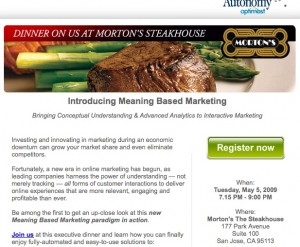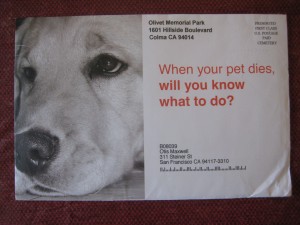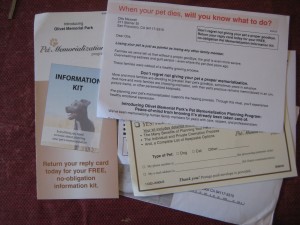When economic times are bad and marketing budgets are tight, every promotion has to work harder than ever to pay back its investment with increased sales, leads or visibility. The good news for copywriters is that often we can improve return on the marketing investment with better response at no increase in costs, simply by wringing out every last benefit and bringing it home to the reader.
But how do you deliver a positive message when the news all around you (maybe even including the news you need to deliver in your copy) is bad? Here are three pointers.
Rule #1: Don’t go negative. Stick to a positive message in your copywriting.
At several points in my copywriting career I’ve felt like I uncovered a powerful “warning” or “caution” theme that outweighed anything positive I could say. And every single time this approach was tested, I’ve been blown out of the water by a bland and generic benefits-oriented message that handily defeated my negative scalpel twist.
The reason, I think, is that readers go through a filtering process before they get to your copy. Themes like “how to survive the coming depression” may be fine for best sellers, but people volunteered to read those books or watch those TV shows. You, on the other hand, are one flick of the finger away from the recycling bin or a click to the next web page. You have to earn a reader’s acceptance before they will permit you to market to them. And if you scare them on your initial approach, they’ll simply run away.
Tip #2: Be nurturing. Write copy your readers want to read.
Today’s consumers, even business people, are hurting and they want coddling however they can get it. If you can take them to a quiet and reassuring place even for a few minutes, chances are they’ll stick with you till you get to ask for the order.
One of the most successful promos I was associated with was a subscriber acquisition package for Great American Recipes during the early 1990s recession. It became the first non-sweepstakes control for this marketer by delivering a message of comfort and nostalgia:
Remember when good food meant the best times you ever had with your family and friends?
I’m talking about lazy summer evenings serving home-made ice cream on the screen porch. The fine feeling of knowing everything was cooked just right, and there was plenty to go around. The warmth of neighbors sharing recipes, in a cozy kitchen on a cold summer night…
We haven’t even gotten to the product yet, but this was already outpacing “you may already have won” even in tough times. And an extra benefit is that the product I’m selling is depicted as taking them back to happier days… so not only are readers more likely to order, they’re also more likely to keep the product (the initial pack in a recipe card continuity program) instead of sending it back when it arrives in the mail.
Tip #3: Be specific. Believable copywriting is effective copywriting.
Readers are extra-crabby and hyper-sensitive when they feel threatened. Even more than usual, they’re on the alert for flabby generalities and statements that are not supported by facts. The truth is your antidote, but you also need to be very clear in your writing so readers know you’re telling the truth.
Non-profit fundraising writers know about this challenge because for them, times in are always bad which is why they are raising money. Herschell Gordon Lewis shares a great example of bad fundraising copy, a letter that stars with a sentence something like “Around 2 million people in the western Sahara will go hungry this summer”. The word “around” is the deal breaker. If the writer didn’t care enough to find a more exact number, why should the reader care?
The other challenge is that huge negative numbers seem overwhelming. It’s terrible if famine threatens a region, but what can I as an individual do to help? On the other hand, if I understand that my $100 contribution saves 40 children with diarrhea, that’s that is something I can manage. Apply the same rigor to your benefit statements or descriptions no matter what the product or service, and you’ll be better off in bad times.
A promotion that follows all these rules is a lead generation letter for a major insurance company. It’s about long term care insurance and it starts with the “bad news” that Medicare is not going to cover your expenses in retirement like you thought it would. The lead sentence of this letter is what makes it work and it’s actually very close to something I heard from a salesman during a brainstorming session:
Every one of us would like to live well in our later years and leave some money for the next generation. Is that too much to ask?
Unfortunately, this modest dream could be shattered if you one day need assisted care in a nursing home… in fact you have a 40% chance of being in a nursing home after age 65. A nursing home stay can be expensive, averaging more than $180,000 nationwide. And it can be demeaning, robbing us of our choice and dignity.
Fortunately, Long Term Care Insurance is now available from ((client name)) that helps retain the very options that expensive long term care takes away…
This delivers one specific jolt of bad news (and carefully modulated outrage) but immediately provides the solution for it and proceeds to coddle and nurture the reader for the rest of the letter. It’s been the control for going on 10 years and I expect it will only do better in the current economy. Try the same formula in your own writing and see if you don’t succeed, good times or bad.
NOTE: I’m in the process of installing the contents of my DMA “Copywriting that Gets Results” course on this website. Watch for more articles and pointers coming soon.







